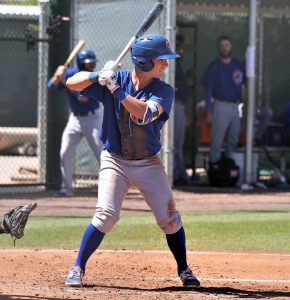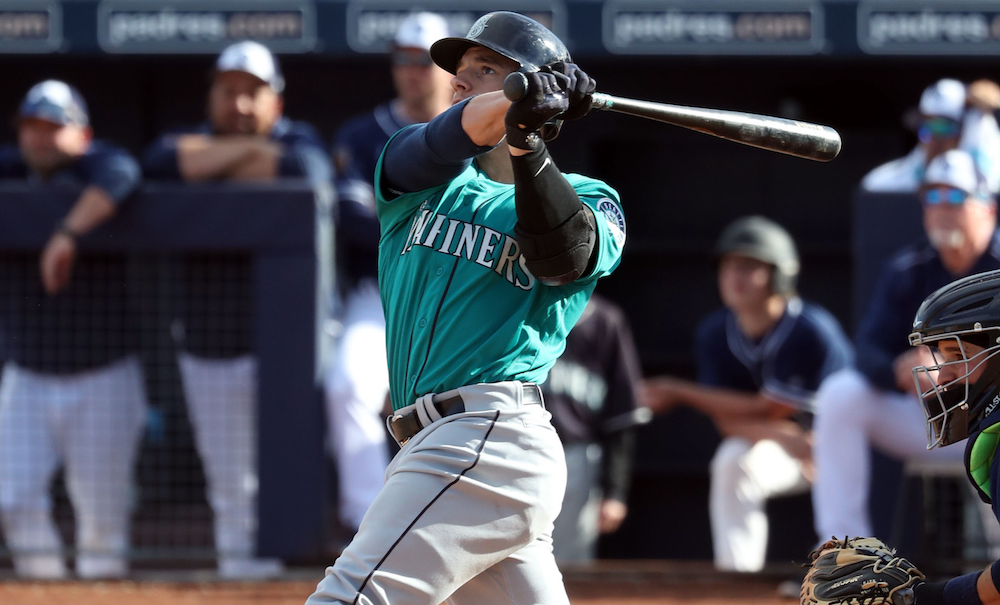Feature Photo: Tyler O’Neill, OF, Mariners
2080’s John Arguello, Alexis Collins, Dave DeFreitas, Nick Faleris, and Mark Shreve all pitch in with unique insights and analysis of six top prospects from around the minor leagues in this weeks 2080 Prospect Spotlights column.
Ed. Note: For the remainder of the 2017 season you’ll be able to access our full season of prospect spotlights by bookmarking our 2017 Prospect Spotlight Table. 2080’s 2017 Prospect Video Library has also been launched.
2080 PROSPECT SPOTLIGHTS
Class A
 Zack Short, 2B-SS-3B, Cubs (Class A South Bend, Midwest League)
Zack Short, 2B-SS-3B, Cubs (Class A South Bend, Midwest League)
Ht/Wt: 5’10”/175 lbs. B/T: R/R Age (as of April 1, 2017): 21y, 10m
Short isn’t your typical prospect. He is originally from Kingston, NY and was drafted in the 17th round of the 2016 MLB Draft out of Sacred Heart University in Fairfield, Connecticut — not exactly a hotbed of MLB prospects. In fact, they’ve never produced a major league baseball player. At the end of his junior year, nobody would blame you if you didn’t think Short was going to be the guy to break that drought. He hit just .241 with three home runs while seeing his strikeouts rise from 35 to 52 in his junior season.

Zack Short, INF, Cubs (Photo by John Arguello)
What’s more, Short is not exactly a physically imposing player. At 5-foot-10 and 175 pounds, he’s certainly not the guy you notice walking off the bus. It’s on the baseball field where the Chicago Cubs noticed Short. What he lacks in physical size, he makes up for with a loose, athletic frame that helps him generate very good rotation in his swing. The result is some surprising pop for a somewhat slender middle infielder. He has a good eye and a disciplined approach, enabling him to draw a lot of walks as well as getting himself into good hitting counts, where he can tap into some of power. Despite the spike in strikeouts his junior year, Short does have good feel for contact. Overall, he is currently hitting .288/.422/.591 with four home runs, three stolen bases, and a 17.1% walk rate for South Bend.
In the field, Short shows good middle-infielder actions. He’s good enough to stick at shortstop, but his athleticism, instincts, and baseball IQ have the Cubs already moving him around the infield. One scout likened him to Red Sox super-utilityman Brock Holt.
Short may not have superstar written all over him, but I think his combination of skills make him an interesting prospect, especially in the current era where versatility is valued so highly. – John Arguello
Double-A
 Kevin Newman, SS, Pirates (Double-A Altoona, Eastern League)
Kevin Newman, SS, Pirates (Double-A Altoona, Eastern League)
Ht/Wt: 6’1”/180 B/T: R/R Age (as of April 1, 2017): 23y, 10m
Newman broke out in a big way last summer, slashing .320/.389/.426 over 102 games split between High A Bradenton and Double-A Altoona, all while posting a 7.8% strikeout rate and 9.4% walk rate. It was not a surprise to see Newman – a former first-rounder and advanced collegiate bat – posting high contact rates and demonstrating advanced feel for the strike zone, but the loud production outdistanced the scouting in certain regards, and questions remained as to whether the young middle infielder was capable of maintaining that level of performance at the upper levels.
While Newman’s current production has been largely consistent with his Double-A performance from the second half of 2016 (.280/.333/.387 in 2017 compared to .288/.361/.378 in 2016), there has been a notable shift by Eastern League arms to a more aggressive approach, as pitchers seem more inclined to roll the dice challenging Newman early in the zone, relying on his high ground ball rates and lack of power to limit potential for damage.
His on-base production, which has dropped from a 73-point delta off his average at Double-A last year to 53 points through the first month of action this year, has carried the brunt of the impact – dovetailing with evaluators’ concerns that his inability to lift and drive the ball could ultimately limit his offensive upside to that of a hollow-average producer, with little in the way of impact on-base or power utility. While still quite early, it’s worth noting the adjustments being made against Newman in Double-A will only amplify as he continues to work towards Pittsburgh, and his ultimate offensive value is going to be directly tied to his ability to leverage his keen eye and contact ability – that means making sure he’s hitting for enough pop to at least keep arms honest. – Nick J. Faleris
 Mike Ford, 1B, Yankees (Double-A Trenton, Eastern League)
Mike Ford, 1B, Yankees (Double-A Trenton, Eastern League)
Ht/Wt: 6’0”/225 B/T: L/R Age (as of April 1, 2017): 24y, 9m
After missing 80-plus games last season with a wrist injury that ultimately required surgery, Ford started this year at Double-A Trenton as if shot out of a cannon, slashing .326/.396/.605 with hits in his first eleven games, before cooling off significantly since then (currently mired in a 2-for-21 slump) and settling at a .250/.351/.453 slash line through April 26. But setting his current slump aside – Ford has shown the ability to make adjustments in prior years – the profile is still encouraging.
Thick-bodied, with a linebacker’s build, Ford has a very strong lower half and core. He generates solid backspin carry to the gaps, stemming from a quiet set up and load, excellent balance throughout the stroke. The swing plane is level with average bat speed, and he keeps the barrel in the zone, while still creating some lift. He shows gap-to-gap doubles pop in BP, and he is showing an increased ability to work the ball to all fields with hard contact, though his in-game over-the-fence pop is mostly to the pull side. He is great at working deep in counts and shows above-average plate discipline (189:183 SO/BB rate as a pro).
At first base, the athleticism is apparent and the soft hands are more than capable of giving you average overall defense, with the range to make the routine plays and to bail out his infielders on occasion. On the base paths he’s a bit of a plodder with well-below-average speed; not threat to steal a bag, but with solid reads and baserunning instincts to avoid being a baseclogger.
He is a fairly polished prospect at this point, with 800-plus plate appearances at the High A and Double-A levels. He’s proven his approach works against advanced pitching (roughly .279 average and .372 on-base percentage across High A/Double-A from 2015-present). If the production at the plate returns, and he remains healthy, the Yankees will be hard-pressed not to push him up to Triple-A Scranton and see what they have. He’s got a moderate-risk floor of a Role 35, up/down first baseman, with the on-base numbers giving him value as a lefty bat off the bench despite not having the true power numbers that you like to see from a corner guy. His ceiling is that of a Role 45 second-division first baseman, good for .270 average and .360-to-.370 on-base percentage, 10 home runs, and his share of doubles while moving between first base and DH. – Mark Shreve
 Cory Taylor, RHP, Giants (Double-A Richmond, Eastern League)
Cory Taylor, RHP, Giants (Double-A Richmond, Eastern League)
Ht/Wt: 6’2”/255 B/T: R/R Age (as of April 1, 2017): 23y, 3m
Taylor was acquired by the Giants in the eighth round of the MLB Draft in 2016, and he began last year with the Class A Augusta Green Jackets, where he made 18 starts, throwing 97 2/3 innings with a 2.58 ERA and 1.27 WHIP. He was promoted on August 5, 2016 for two starts with Double-A Richmond before moving to High A San Jose to finish the season. For the season, he started 23 games throwing 119 innings with a 2.72 ERA and 1.30 WHIP. In viewing two of his first four starts for the Flying Squirrels, Taylor was hit hard in both games, giving up nine hits and six earned runs over 8 2/3 innings while striking out eight, but he was able to work himself out of multiple jams by keeping the ball on the ground and working down in the zone.
Taylor has a thick frame with sloped shoulders and a muscular lower half. The high-3/4’s arm slot helps to create great angle, but the arm action lacks any meaningful deception and he has been challenged to repeat the delivery, which is likely the root of his early control issues (8.30 BB/9) this season. It does, however, generate downward plane on his pitches, making it tough for hitters to work the top-half of the ball.
Taylor has an average fastball, which he can vary from 89-to-93 mph (T94). He displayed an average changeup that showed late fade and he went to it often, making it apparent his level of confidence with his go-to off-speed pitch. His third offering is a fringe-average slider, which he threw to both righties and lefties. It sits 79-to-83 mph, but it was lacking tilt in these views and his feel was below average. He is however, confident in his three-pitch repertoire and isn’t afraid to use any of his mix in any count.
With a fringe-average to average stuff across the board, Taylor will need to continue working to improve his control and command of all three of his pitches. If he can get his walk numbers down, and continue to generate swing and miss (15.23 SO/9), and do better to keep the ball on the ground (0.67 GO:AO ratio) as the season progresses, he could have some value as a spot starter or swingman at the big league level. However, if the fastball command and feel with his secondary stuff settles in at below average, he will be hard pressed to add impact beyond being the last man in the bullpen. – Alexis Collins
Triple-A
 Dinelson Lamet, RHP, Padres (Triple-A El Paso, Pacific Coast League)
Dinelson Lamet, RHP, Padres (Triple-A El Paso, Pacific Coast League)
Ht/Wt: 6’4”/187 B/T: R/R Age (as of April 1, 2017): 24y, 3m
After taking a fairly roundabout way into the Padres’ organization that included a year-long suspension for some mis-managed documentation, Lamet made up for lost time in 2016 when he started at High A and finished the year in Triple-A. Lamet has always had power stuff, but the 70-grade heater he brought out last week versus Tacoma was something special. He was locating it to all quadrants with late tail down in the zone, and with significant late hop in the zone up above the belt. He is primarily a fastball/slider guy, but the slider is a 65-grade offering that is a true out-pitch, and it will miss bats in the big leagues. The changeup is coming along, but right now is still quite firm and lacks any real depth. However, given how the arm works, it is not a stretch to think that he can get it to average, which when paired with the rest of his arsenal should be more than enough for him to turn over big league lineups.
The main knock on Lamet at this moment is that while the command has taken a step forward, the plate can still jump around on him at times and when he does miss, it tends to be out over the plate. Obviously, he has significant margin for error, pitching in the mid-to-upper 90’s with a swing-and-miss breaking ball, but at the major league level, those issues will be quickly exploited. He has done a nice job keeping the ball on the ground so far this year (1.67 GO:AO mark through four starts, up from 0.88 mark in 2016) and his strikeouts are up (12.6 SO/9 versus approximately 11 SO/9 last year) after punching out 22 over his last 12 ⅓ innings. Lamet’s actions are very smooth and the easy arm speed he generates translates to double-plus life in the zone, and it’s reminiscent of Danny Salazar (RHP, Indians) at around the same age. The Padres aren’t in a rush to get Lamet to the show, but if he can show progress with a third pitch and continue to improve his command, it would not be a shocker to see him debut at some point in the next eight weeks. – Dave DeFreitas
 Tyler O’Neill, OF, Mariners (Triple-A Tacoma, Pacific Coast League)
Tyler O’Neill, OF, Mariners (Triple-A Tacoma, Pacific Coast League)
Ht/Wt: 5’11”/210 B/T: R/R Age (as of April 1, 2016): 21y, 10m
Young for the level at Double-A last season, O’Neill continues that trend as he dives into Triple-A Tacoma this year. He is off to a slow start, and he had a rough go with the swing and miss last week, as he struck out nine times in 27 at-bats at one point. When he has put the bat on the ball, however, he has done damage, with eight extra-base hits, including three home runs. But like we have mentioned before with O’Neill, the big question for him is will he be a guy who makes enough contact to have the big power turn his profile into an above-average everyday contributor, or will the strikeouts drive him into a one-true-outcome type of player.
He likely will always have stretches like he did last week, where at-bats seem to slip away from him and he gets easy to pitch to, ultimately eating into his value in the on-base department. The key for him is going to be how quickly he can pull himself out of those funks and get back to putting together good at-bats. It’s still early in the season, and we are talking about a kid that is just short of 22 years old, but he will need to get more comfortable hitting with two strikes and limit the chase mode that can render his power useless. If he can start to show some ability to battle back after going down 0-2 and 1-2, not only does he increase his chances to get a mistake to hammer, but the act of simply seeing more pitches is an aspect that makes his at-bats a little bit higher stress for opposing pitchers. – Dave DeFreitas


